Changing lives: The history of Purdue Space Day





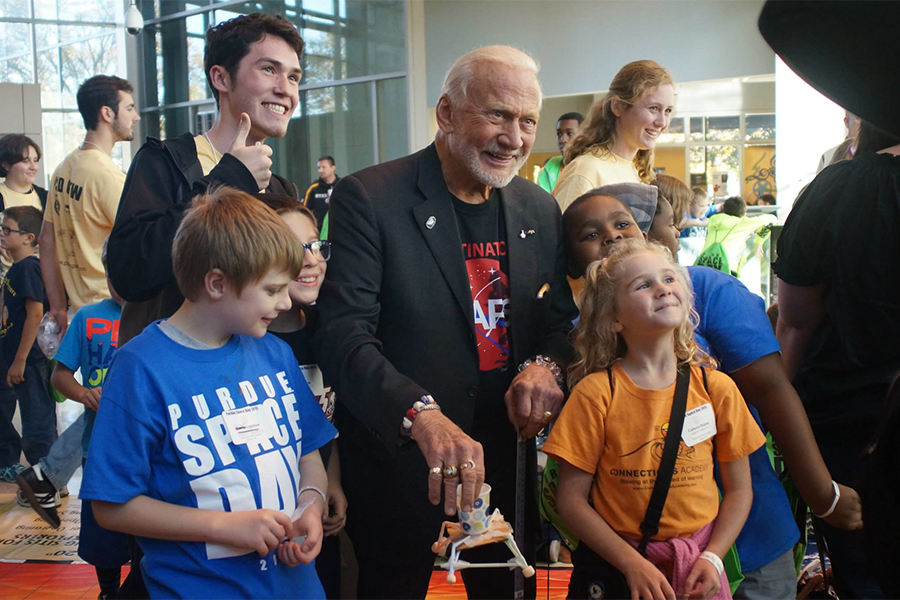



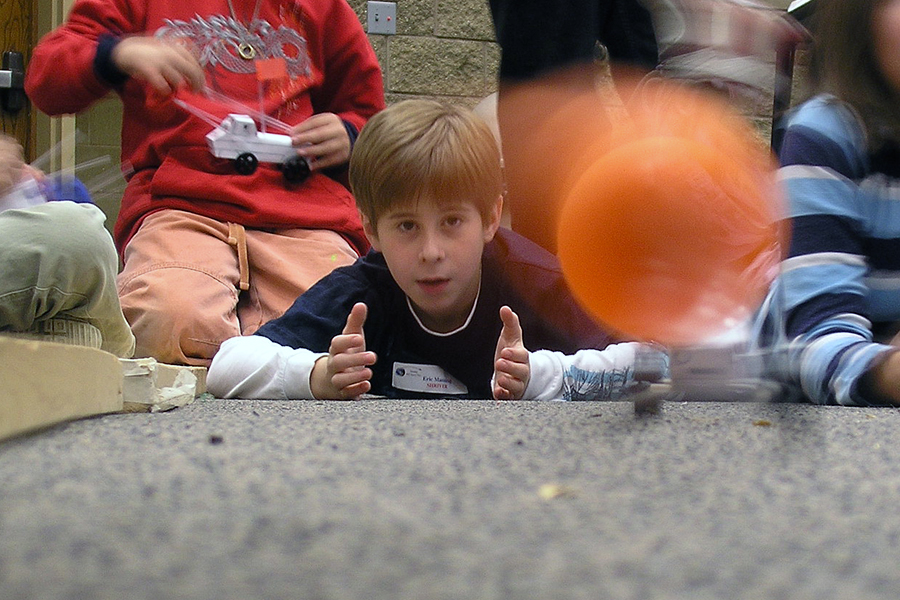







As a sophomore in high school, Cindy Mahler received a scholarship to attend Space Camp in Huntsville, Ala.
She’d long since identified a love for space, harboring aspirations of becoming an astronaut, and when she found herself surrounded by like-minded souls, she felt like she belonged.
“That was the first time I was somewhere where I felt I was with people who understood me. I was with my people,” she said. “Growing up in lower-middle class at the time, there just wasn’t a lot of exposure or experience that you could tap into.”
Two years later, Mahler attended a talk at Notre Dame — she grew up only five miles from campus — that featured astronaut alumnus Jim Wetherbee. It was the first time she’d heard a first-hand account from an astronaut. She was in awe. And had a distinct realization: This is actually attainable.
Once she arrived at Purdue in 1994, Mahler quickly got connected with Purdue’s Students for the Exploration and Development of Space (SEDS) chapter as educational outreach coordinator. It didn’t take long to develop plans. At first, Purdue students went to local schools and gave talks in classrooms about space. Then, they did a “Spring Rocket Day” for kids on a Saturday.
By February 1996, Mahler started thinking bigger.
“I wanted to provide something to students that they otherwise might not get,” she said. “I wanted to target lower-income neighborhoods or schools. It was about exposure and letting kids dream and see what’s possible and change their lives, theoretically.”
And Fall Space Day was born.
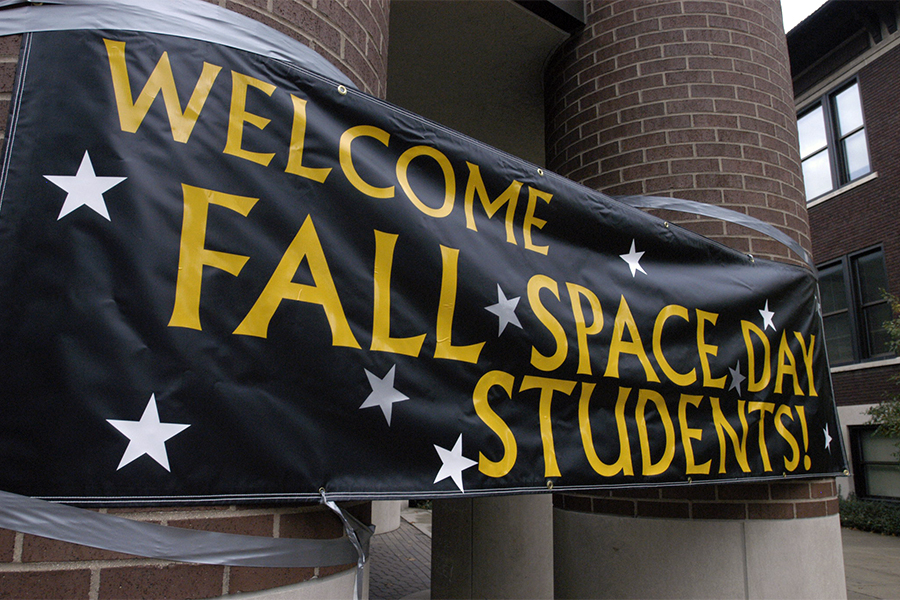
In November 1996, Mahler gathered a group of friends mostly, about 40 or so volunteers, to help execute a one-day event that hosted third graders through seniors in high school on campus in West Lafayette. Mahler and Space Day volunteers wrote and sent letters to teachers at local schools in Lafayette and West Lafayette and even reached out to Indianapolis schools, inviting teachers to sign up classrooms for a field-trip-type experience for students to learn about astronautical engineering and space exploration. Another perk: Based on her personal experience, Mahler wanted to have an astronaut speaker, hoping the kids could be inspired and, also, have the unique experience of interacting with an astronaut.
About 150 participants attended the first Fall Space Day.
It has continued to grow since.
“I don’t think there’s ever been a year that we haven’t been full or gone over the numbers. There’s always more interest than what can be provided to the students,” Mahler said.
In 2019, the program — renamed Purdue Space Day in 2007 when it became an independent student organization — had a record 855 participants and nearly 400 student volunteers. That participation number will balloon in 2020 in the program’s 25th anniversary year, as COVID-19 forced the event to move to a virtual format, allowing unlimited registration. As of early October, more than 4,100 had signed up.
Including 2020, approximately 16,000 kids have participated in the program in 25 years.
Really, the interest level isn’t surprising.
What Mahler created in 1996 and what Purdue Space Day has become hasn’t been replicated.
“While there are some large STEM-related events, this is the only space-themed event, to this scale, that I know about. The Purdue Space Day brand is very prestigious, and it relies on the fact that this has been such a longstanding and successful program,” said Elmer F. Bruhn Associate Professor of Aeronautics and Astronautics Michael Sangid, who has been faculty advisor for Purdue Space Day since 2014. “Because of the organization and dedication of the coordinators and the tireless efforts of the PSD executive board, kids and parents never leave disappointed. They all want to come back and tell their friends to attend in future years. It’s through these positive experiences and word of mouth that PSD has continued to grow.”
It’s a program that has produced lasting memories, not only for the school-aged kids who attend but for all of the volunteers, executive board members, coordinators and, even, the VIP guests.
Special guests
Setting Space Day apart has been its ability to feature an astronaut every year, usually one with Purdue connections. Purdue counts 25 alumni among its “Cradle of Astronauts,” 16 of whom are AAE graduates.
The astronaut involvement has allowed the event to be truly special: Not only is there tremendous value in reaching kids at an influential age with STEM-related activities, with a multidisciplinary space slant, but there’s a real-life hero interacting with them throughout the day during those activities.
Name an astronaut who has participated — there have been 18 — and every one has been side-by-side with kids during the day’s activities, which are separated into groups of third and fourth graders, fifth and sixth graders, and seventh and eighth graders. Charlie Walker has dropped kids’ experiments out of a window in the Physics building. Jerry Ross has gotten down on his knee to assist in launching water rockets. Gregory Harbaugh has offered tips on rocket designs.
Rubbing elbows with men and a woman who have traveled in space, after hearing about those adventures firsthand in a presentation to start the day, is exactly what Mahler envisioned in Year 1.
“Astronauts are a big deal when you’re at that age,” Mahler said. “We brought them all together … and the kids are just so happy and so excited.”
At the end of each Purdue Space Day, each group of kids poses for a photo with the astronaut, providing a neat keepsake. The ambitious ones will ask for autographs throughout the day or, these days, request a selfie.
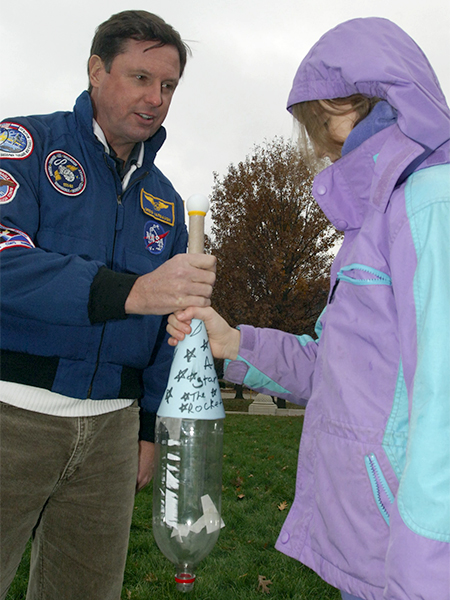
It seems at every turn, the astronaut guest obliges. Really, how could they not?
“I’m passionate about this because these kids are the future,” Walker said when he was on campus in 2018 for his third PSD. He’s also one of the VIP guests for the 2020 virtual event.
Passion is where it all began.
Mahler jokes her love of space exploration is ingrained because her dad held her while he watched reruns of Star Trek in the 1970s. In fifth grade, she joined her school’s “Young Astronauts” program. That was the same year of the Challenger explosion, an event she saw unfold on TV. Mahler said she vowed that day, she would grow up and “finish their mission for them.”
In high school, Mahler was charged with a career day assignment to write to three people in the career she was interested in. She sent a letter to NASA, requesting any astronaut to come to her school and speak. None did — there wasn’t money to get them there from Houston. Instead, mail started to flow to Mahler’s house. Mission patches. Autographed photos. Stickers. And 25 replies to the form she’d sent.
Don Williams, an AAE alum, filled out the sheet extensively. So years later when Mahler was working to make Fall Space Day a unique event, she reached out to him again.
His response: “I’d be more than happy to do it.”
He wasn’t the only one. Unsure of whether she’d be able to land an astronaut for the event, Mahler actually asked two to attend: Williams and another AAE alum, Gary Payton. Payton said yes, too, resulting in quite the Year 1 treat.
The only other year in the event’s first 24 that had more than one VIP astronaut guest on campus was 2012 when Drew Feustel joined Scott Tingle and David Wolf, all active astronauts at the time.
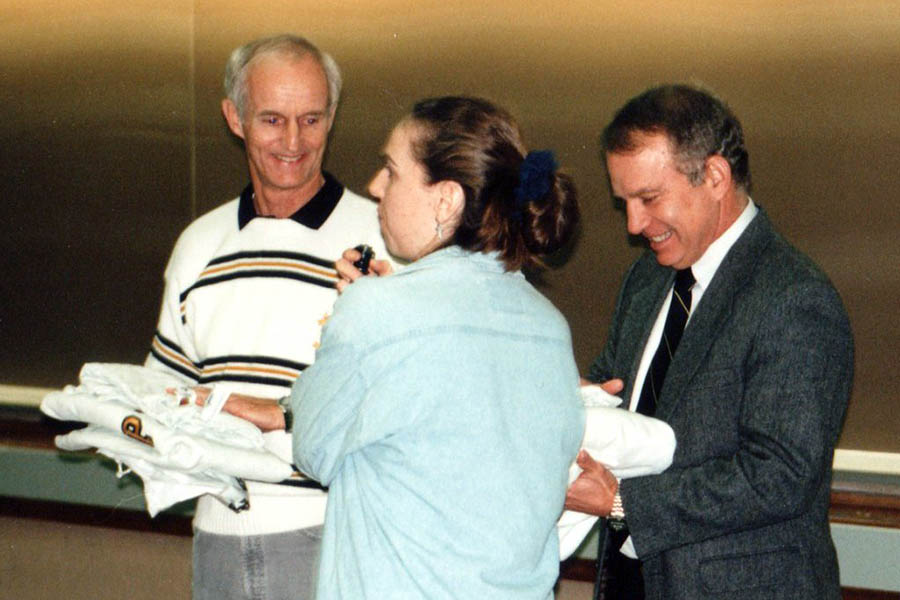
Inspiring the next generation of space explorers by any means possible.
And not necessarily only the young ones.
Even Purdue students have been found to be in wonder of the astronauts, though that tends to pivot more toward admiration by the end of the festivities, after they’ve been blessed to spend meals with the guest, seeing them in a regular-person light. A “regular person” who has done incredible things.
“It was amazing,” said Allissa Battocletti Noffke, an AAE alumna who served as PSD director in 2010 after being assistant director and a volunteer before that. “For a lot of people who want to be in the industry, that networking opportunity to get to know someone is invaluable. Astronauts, especially, have so many cool stories about how they got to be where they were, who mentored them, how they gained leadership experience. Not even necessarily for the goal to be an astronaut yourself, but it’s someone who is so established in the industry, there’s just a lot of wisdom to hear. Any volunteer, any student who spent time with them during the day gained inspiration. They’re so inspirational and such good speakers.”
Making changes
After the first Fall Space Day — it had “fall” in the name because the initial thought was to pair it with a “spring” aviation day, but the latter never materialized — Mahler spent winter break documenting everything. She desperately wanted Space Day to be built for longevity. That meant creating an executive committee, assigning different roles so one person wasn’t doing the majority of the work. She asked for the help, too, from the School. John Sullivan, AAE’s head at the time, hired a part-time staff member, Lillie Fisher, to assist in the planning and organization.
Mahler said the addition of a staff coordinator helped because it “transitioned you through the different executive directors and added some consistency to the program.”
In 2000, Ann Broughton joined AAE as coordinator, a role she held until 2014. Broughton brought new ideas and was ready to move the program forward, even though she knew immediately Space Day was special.
“The excitement that the children and Purdue students and volunteers had was amazing,” Broughton said. “It was a logical step to increase the numbers as PSD had more support from AAE, the Indiana Space Grant Consortium, the College of Engineering and Purdue in general.
"The numbers continued to increase, and we had to move out of CL50 to the Elliott Hall to accommodate everyone who wanted to come.”
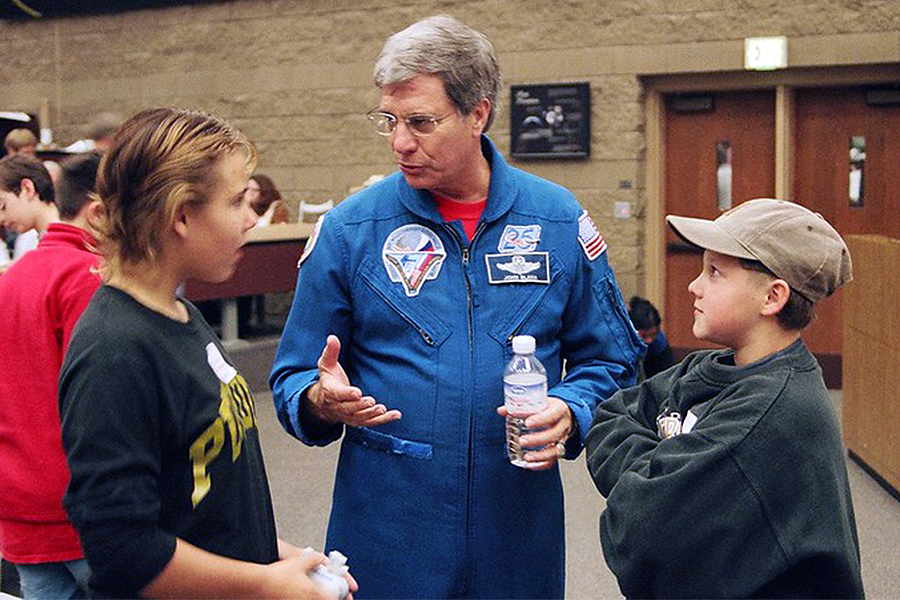
One of Broughton’s first moves was instituting a policy of succession planning, a rolling program in which students would perform all the different aspects of the event before being allowed to become director. She said it was to ensure that only students with experience of working Purdue Space Day were able to be on the executive board and then become leaders.
“Only students who had a passion for educational outreach were able to be in a lead situation and attract students from outside the STEM disciplines,” Broughton said. “At one point, we had student volunteers from 41 majors. It’s probably much higher now.”
The program still wasn’t an independent student organization in those early years, and responsibilities were divided between Purdue’s SEDS chapter, its American Institute of Aeronautics and Astronautics (AIAA) chapter and the Purdue Engineering Student Council.
Broughton started looking into Space Day becoming independent. After the paperwork was completed in 2007, the name was changed to “Purdue Space Day,” and the program came solely under the auspices of the School of Aeronautics and Astronautics. The same year, a PSD Advisory Committee was established with past directors as founding members.
The shift to an independent student organization made sense financially, for one, Broughton said, as it was more practical to have one account for Space Day. But it also was clear Space Day was going to continue to grow, and it was attracting attention from other universities, Broughton said.
Broughton said with the backing of the Indiana Space Grant Consortium and director Barrett Caldwell, a Purdue professor, discussions were held about the possibly of sharing the format and the model with other educational institutions around Indiana and then neighboring states. The model was presented at multiple conferences, not only to highlight the educational opportunity of the program but also as a professional development opportunity for college students.
But, for whatever reason, few universities have attempted anything like Purdue Space Day. That’s left Purdue plenty of time to strengthen its own model.
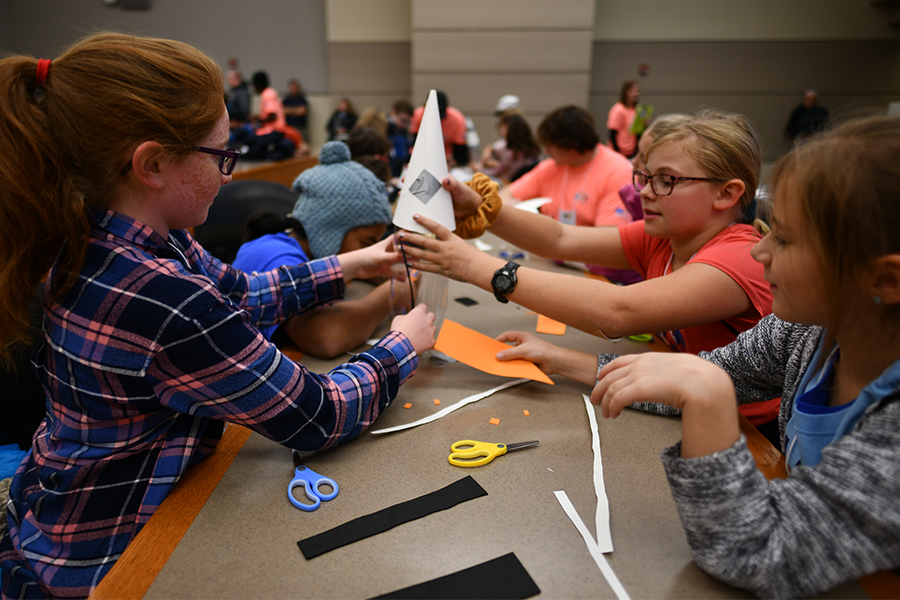
Before the internet was prevalent for disseminating information, volunteers sent letters to target participation. In 2003, then-PSD director Jen Watson created a website that included an online signup, though paper signups still were sent to schools within 90 miles of Purdue to allow children without access to a computer to register. Later, social media was added to the mix.
Indiana Space Grant Consortium has continuously supported the program and is a significance influence, and several industry partners have joined, too, along with local and national organizations. But Purdue students also have had to apply for grants over the years for the program to remain financially independent, allowing them to gain valuable experience at the task.
Though the one-day October event is the anchor, Purdue Space Day actually is not a one-time thing. As the program grew, student volunteers set up educational outreach that visited local schools and also invited small groups of school students to Purdue, Broughton said. An “outreach coordinator” position was developed in 2017, and AAE Ph.D. candidate Geoffrey Andrews spearheaded an extension of the one-day event in that role. Since the creation of that role, the in-school classroom outreach events have reached more than 2,500 students, Sangid said.
In 2018, a Space Day Ambassadors program was created to generate a consistent group of volunteers, more akin to a traditional student club or organization, Andrews said.
Focus on kids
One thing hasn’t changed much over the years: The electric environment on Space Day.
Whether kids and parents lined the seats in the Class of 1950 lecture hall or filled in Elliott Hall of Music, as soon as the astronaut guest walked into the room, the excitement was palpable. Jaws literally dropped. Eyes widened. Smiles stayed, rooted, on faces. Hands shot up at the speed of light, eager to ask questions, even before the designated time.
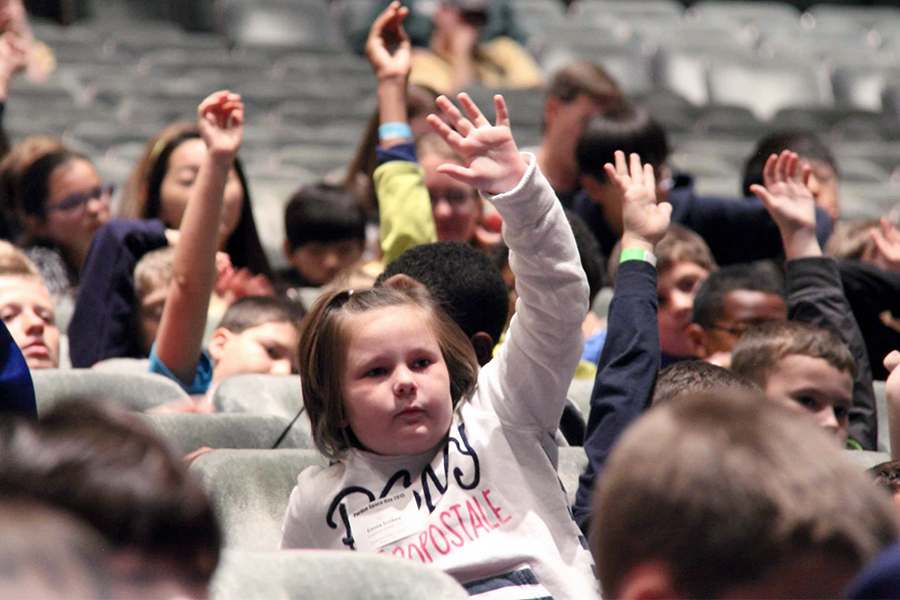
And that’s only the beginning.
Kids flood campus after that morning astronaut presentation, stacked in classrooms, enthusiastically awaiting distribution of construction paper, straws, marshmallows, scissors, whatever the necessary materials needed to start their activity. Each task is selectively chosen for the age groups and led by Purdue students, and each has a learning objective so kids can walk away with knowledge gained — and fun had.
It’s been important, too, to showcase that space exploration is multidisciplinary. Sangid said a main goal is to present well-balanced activities that include propulsion, materials, controls, design and more.
“I am amazed by the genuine enthusiasm and excitement of the kids, as well as the student-led executive board and volunteers,” Sangid said. “The kids have such an amazing curiosity that was galvanized by PSD.”
Broader impact
The kids certainly are the impetus for Space Day, not only sparking interest in STEM but also giving them an opportunity to explore Purdue and learn about its strength in engineering. But Space Day has left much broader impressions over the years.
Some Purdue students who have served on the executive board have had their lives profoundly impacted.
Paige Hiday grew up in Lafayette and attended Space Day as a kid, then volunteered for the one-day event while she was in high school and continued to serve once she started attending Purdue. And though Hiday didn’t graduate with an aerospace engineering degree — her bachelor’s is in biological and food process engineering — she’s thankful for the scope of friendships she developed with students in other majors and disciplines.
When Hiday was assistant director in 2013, her mother was diagnosed with cancer. Kathryn Johnson, one of the PSD directors at the time, was quick to offer support, telling her not to worry about being present for PSD meetings or the workload and “come when you need. We’ve got you.”
“Those became the people I relied on for my support network,” Hiday said. “When I struggled, they were always checking in. My PSD family was always there for me.”
The bonds formed are only part of the reward.
The experiences gained on the exec board have significantly influenced careers after Purdue.
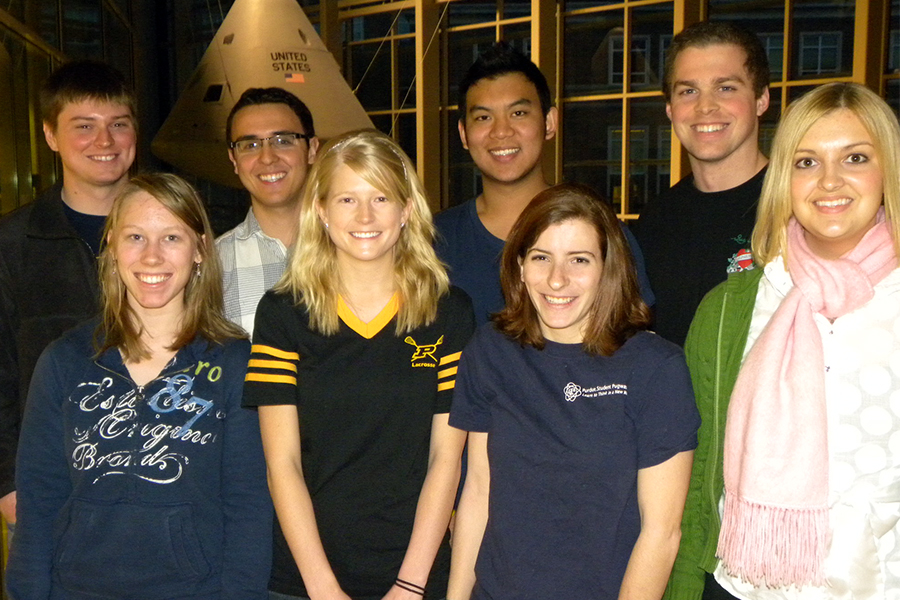
Hiday, an operations supervisor for Kellogg’s, said she learned how to manage teams and interact with people and how to work on long, extended projects.
Noffke said her experience on PSD’s exec board helped solidify that she was really interested in operations and interested in working with personnel. She learned that she loved putting a team together and appreciated the structure of the board, allowing people to thrive because they knew whom they were reporting to and their job responsibilities were clearly communicated. Noffke said that structure mirrors the positions she found herself pursuing in her career.
“There’s just so many opportunities for professional development in an operational structure. It fed the fire that I then took into my career path,” said Noffke, who works in Flight Operations at the Johnson Space Center in Extravehicular Activities.
Mahler earned NASA’s Silver Snoopy award — the highest award given by astronauts, to less than 1 percent of the workforce — only three years out of college, and she credits her experience with Space Day. Mahler felt so strongly about the leadership gained through the program, she established the Purdue Space Day Leadership Scholarship in 2019, awarded to undergraduate students with at least two years’ experience as a PSD volunteer and one year in a leadership role.
“The critical thinking and technical skills that came from my engineering degree — to be able to understand complex information and boil it down into what needs to be known — helped establish a career in aerospace engineering. But I don’t know if I would have been as successful in my career if I didn’t have that Purdue Space Day project management skill behind me,” Mahler said.
There’s no evidence the event will slow anytime soon.
And that’s good news for everyone involved, from Purdue students, volunteers, coordinators, faculty advisors, the School, the event’s sponsors and, of course, the kids.
“I think it’s really important that Purdue continues to engage like this and continues to offer this,” Noffke said. “I know there are students who come out of that day igniting their passion for STEM. Even if it’s not aero-astro specifically, they end up going into STEM fields. The fact it’s something Purdue students are so passionate about, that really can make a difference in shaping the direction someone’s career goes, I think it’s super important to keep offering that.”
